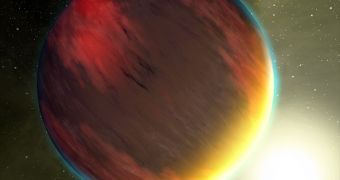A team of investigators that included Alan Boss from the Carnegie Institution for Science (CIS) Department of Terrestrial Magnetism has recently determined that hot-Jupiter-class extrasolar planets can prevent the formation of Earth-like worlds early on in their development.
Researchers figured out that the gas giants tend to display movement patterns in their orbits that have significant gravitational effects on other worlds that may be forming around the same parent star.
The discovery is bound to help investigators gain a better understanding of the patterns and clues they need to be on the lookout for when searching for rocky planets around stars. Even in our own system, these findings may help explain the current planetary configuration.
When they form, gas giants need some time to establish themselves in a permanent orbit. Before this happens, they move back and forth, influencing all other worlds around them, due to their massive size.
In the solar system, Saturn and Jupiter are believed to have moved very close to the orbit of Mars shortly after their formation. Fortunately, this did not throw Earth, Mercury, Venus or the Red Planet out of the system, or into the Sun.
Details of the new study were published in the May 7 issue of the esteemed journal Proceedings of the National Academy of Sciences (PNAS). The team behind the research was led by expert Jason Steffen, who holds an appointment with the Fermilab Center for Particle Astrophysics.
Investigators used data provided by the NASA Kepler Telescope, which was launched with the specific purpose of detecting Earth-like planets around other stars. However, the observatory discovered thousands of planetary candidates, including many hot Jupiters.
A hot Jupiter is a gas giant around the same size and mass as the largest planet in our solar system, except it is located very close to its parent star. This means that its surface temperature is extremely high. In all likelihood, most hot Jupiters are tidally locked to their stars as well.
Over the past couple of years, Kepler has identified 63 systems containing this class of planets. None of these systems revealed any evidence that these worlds had companion planets. It could be, however, that the rocky worlds are simply too small for current technologies to detect.
“The implications of these findings are that systems with Earth-like planets formed differently than systems with hot Jupiters,” Boss explains, quoted by Astrobiology Magazine.
“Since we believe that hot Jupiters formed farther out, and then migrated inward toward their stars, the inward migration disrupted the formation of Earth-like planets. If our Sun had a hot Jupiter, we would not be here,” he concludes.

 14 DAY TRIAL //
14 DAY TRIAL //